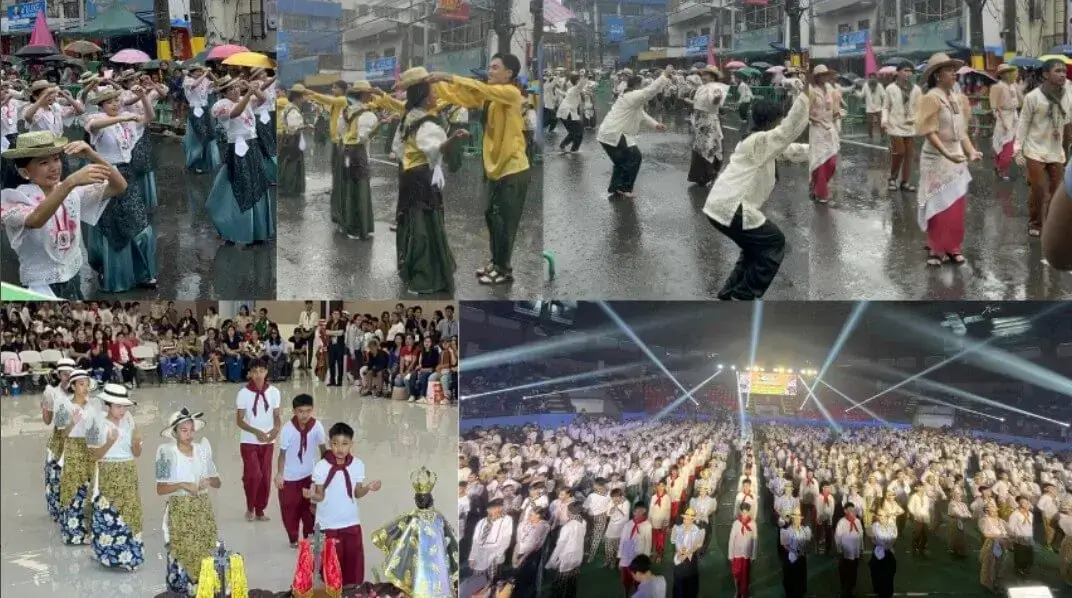
Not even the rain and southwest monsoon could stop the Sublian Festival held from July 21 to 23, 2025, in Batangas City.
This 38-year-old festival began in 1988 under the leadership of the late city mayor Eduardo Dimacuha, in celebration of Batangas City’s founding anniversary. This was my first time attending and experiencing it, and I can say—sulit ang biyahe.
I had the chance to witness some of the activities, with a special highlight on the traditional Batangueño dance, the Subli, which the festival itself was created to preserve.
Experiencing the Sublian Festival for the first time brought the same kilig and excitement I felt when I visited Lucban, Quezon, for the Pahiyas Festival, and when I saw, with my own eyes, the T’boli artisans of Lake Sebu, South Cotabato, weaving the intricate T’nalak textile.
Seeing Subli in a New Light
For those unfamiliar, Subli is a devotional dance that originated in the province of Batangas and is offered in honor of its patron, the Mahal na Poong Santo Niño.
Last week, I was fortunate to witness it firsthand. As a heritage enthusiast, I was already familiar with Subli—but I came to know it on a much deeper level through the Sublian Festival.
There are three known versions of Subli: Agoncillo, from the town of Agoncillo; Sinala from Bauan; and Talumpok from Batangas City.
Among the three, Talumpok Subli is believed to be the oldest, tracing its roots back to the pre-colonial era as a form of pagan ritual. It is the simplest and most grounded version—far from the highly stylized school performances and well-choreographed repertoire we often see on YouTube.
Here, there are no bamboo castanets, no guitars, and little to no ornamentation—just drums and sticks, most likely the same way their ancestors danced it hundreds of years ago.
The male dancers move with speed and agility, while the female dancers respond with grace and fluidity, all carried by the raw, steady rhythm of the drum. The overall presentation feels deeply rooted—serious, ritualistic, and grounded—a glimpse into something sacred and enduring.
This is the version that the Cultural Office aims to preserve and promote, as it is the one they can truly call their own.
The Renaissance of Talumpok Subli
It’s clear that a renewed passion for preserving the Talumpok Subli is taking root. Thanks to festival director Peter John Caringal, this very version was proudly performed and showcased by elementary, secondary, and college dance troupes from across the city during the Traditional Subli Dance Competition held on July 21.
“‘Yong pride ng Batangas City is ‘yong Talumpok [Subli] so ’yon ang ginawa namin… Ngayon po, may focus tayo. Ang focus namin, mas mapalakas pa namin ’yong Talumpok [version] (The pride of Batangas City is the Talumpok Subli, so that’s what we focused on… Now, we have a clearer direction. Our goal is to further strengthen and promote the Talumpok version),” Caringal shared during the briefing with the judges at Batangas City Convention Center.
Because of its unique characteristic and rich history—believed to be a living link to ancestral beliefs layered with Christian faith—the Talumpok Subli has become a symbol of heritage, identity, and resilience for the people of Batangas City.
One way to preserve this intangible heritage is through school and community-based competitions that encourage participation and keep the tradition alive.
“Kapag sinabi naming competition ng Sublian, hindi ibig sabihin nu’n competition [talaga]. Ito ay unity. Blessing na lang sa amin ’yong mabigyan ng award (When we say Sublian competition, it doesn’t mean we’re competing in the strictest sense. It’s really about unity. Being given an award is simply a blessing),” he pointed out.
“Kasi ang aim namin, lalo na ako, matuto ang mga bata sa tradisyonal [sayaw] na meron ang Batangas City. Pag ito’y inalis mo, ano pang maipagmamalaki namin sa sining at kultura? (What we really aim for—especially for me—is for the younger generation to learn the traditional dance of Batangas City. If we take that away, what else can we be proud of in terms of our arts and culture?)” he added.
Through the efforts of the Cultural Office and the support of the local government, there has been a noticeable resurgence of appreciation for the Talumpok Subli among the youth.
“Sabi nila [students] mas malalim na ’yong kanilang idea ngayon sa Talumpok. Dati parang hindi raw sila interested. Kasi nga ganu’n lang daw [kasimple] ang galaw… Ngayon, makikita n’yo malaki ang pinag-iba ng Talumpok (They say they now have a deeper understanding of Talumpok. Before, they weren’t that interested, because the movements seemed too simple. But now, you can really see how much the Talumpok Subli has evolved),” Caringal proudly shared.
Moreover, the city continues to embrace the Sinala and Agoncillo versions as well. In fact, before this year’s Traditional Subli Competition, all three versions were presented. Elders of Batangas who have long performed the Subli danced once more—alongside the grandchildren of the original dance masters.
Additionally, in the community category of the competition, groups performing the Sinala and Agoncillo versions were also welcomed and encouraged to participate.
Heritage Meets Contemporary
To further promote and preserve the Talumpok Subli among today’s generation, it has been used as the foundation for Batangas City’s street and court dancing competitions. The result? A vibrant display of colors and movements that are uniquely and authentically Batangueño—a celebration the community can truly take pride in.
In fact, Sublian is one of the few festivals in the Philippines directly patterned after a traditional folk dance. The only other two I know of are the Pandang Gitab Festival of Oriental Mindoro, inspired by Pandanggo sa Ilaw, and the Binanog Festival of Lambunao, Iloilo, rooted in the Binanog dance.
While many Philippine festivals strive to match the grandeur of Cebu City’s Sinulog and Iloilo City’s Dinagyang—two of the country’s largest in terms of costumes, staging, and spectacle—Batangas City’s Sublian has chosen to remain grounded in its roots. It draws strength from its history, identity, faith, and deep devotion to the Santo Niño.
Three years after its revival, following a pandemic-related pause, the festival has come a long way—firmly establishing its uniqueness among Filipino fiestas.
In the Sublian street and court dance competitions, the choreography has become more creative, theatrical, and precise—yet the traditional foundation of Subli remains firmly intact.
The costumes have also embraced a more traditional direction, thanks to the expertise of designer, choreographer, and Filipiniana advocate Rommel Padillo Serrano, who led a costume workshop months before the competitions. His guidance helped ensure that the attire remained faithful to cultural roots, enhancing the authenticity of the performances.
The Youth and the Talumpok Subli
The recently concluded celebration was a promising sign for the heritage of Batangas City. Its cultural foundation has been reset, its sail has been unfurled—there is now a clear direction ahead. This movement rests in the hands of passionate advocates who remain committed to preserving what is truly theirs.
The participation of young Batangueños was also worth highlighting. It is a clear indication that, despite the demands of our digital age, there is a generation willing to dedicate their time and energy to meaningful cultural activities. To me, that is a noble and hopeful sign.
In a world where many young people are immersed in mobile games and social media—and in an era of globalization where popular foreign culture is heavily promoted and prioritized by mass media—there is still a bright light of hope for our rich and beautiful heritage.
The success of this year’s festival is proof that there are young Filipinos who genuinely love their local culture and embrace their traditions—not merely for cash prizes, recognition, or academic requirements, but out of true devotion.
To grace the stage, the hall, or the street—even amidst the pouring rain—wearing traditional attire and swaying, spinning to the ancient steps of faith, is no longer just an act of cultural expression. It is an act of patriotism. A bold and graceful declaration that our heritage lives on, rain or shine.
And with what I have witnessed in Batangas City, I am truly excited for the Sublian Festival in the years to come.
Mabuhay ang mga Manunubli ng Batangas! Mabuhay ang mga nagtataguyod sa mga katutubong sayaw ng Pilipinas!
Read more Good Travel stories from Atom Pornel here:
- Inside the Colors of Pahiyas: A Celebration of Faith, Heritage, Harvest, and Community | Atom Pornel
- Cultural Threads: Tracing Traditions from Davao del Sur to South Cotabato | Atom Pornel
- Brewing Memories: Chocolate, Coffee, and Cultural Discoveries in Davao City & Davao del Sur | Atom Pornel
- 24 Hours in Davao City: A Day of Culture, Cuisine, and Scenic Views | Atom Pornel
Join our vibrant Good News Pilipinas community, where we celebrate the achievements of the Philippines and Filipinos worldwide! As the Philippines’ No. 1 Website for Good News and proud winners of the Gold Anvil Award and Lasallian Scholarum Award, we invite you to connect, engage, and share your inspiring stories with us. Together, let’s shine a spotlight on the stories that make every Filipino proud. Follow us on all platforms through our LinkTree. Let’s spread good news and positivity, one story at a time!










